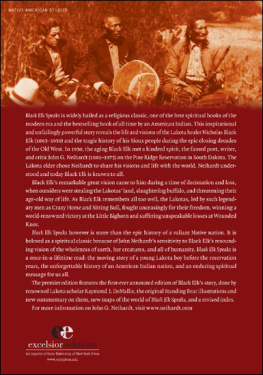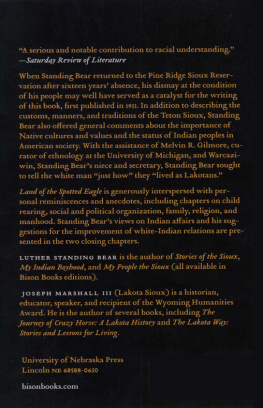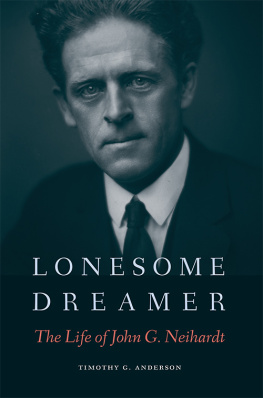
Other books by John G. Neihardt
published by the University of Nebraska Press
All Is But a Beginning: Youth Remembered, 18811901
The Ancient Memory and Other Stories
A Cycle of the West (Golden Anniversary Edition)
The Dawn-Builder
The Divine Enchantment: A Mystical Poem and Poetic Values: Their Reality and Our Need of Them
The End of the Dream and Other Stories
The Giving Earth: A John G. Neihardt Reader
Indian Tales and Others
Knowledge and Opinion: Essays and Literary Criticism of John G. Neihardt
Lifes Lure
Lyric and Dramatic Poems
Man-Song
The Mountain Men (Vol. 1 of A Cycle of the West)
Patterns and Coincidences: A Sequel to All Is But a Beginning
The River and I
The Splendid Wayfaring: Jedediah Smith and the Ashley-Henry Men, 18221831
The Twilight of the Sioux (Vol. 2 of A Cycle of the West)
EAGLE VOICE
REMEMBERS
An Authentic Tale of
the Old Sioux World
by
JOHN G. NEIHARDT
Foreword by Coralie Hughes
Introduction by Raymond J. DeMallie

1951 by John G. Neihardt
Introduction to the New Edition 1991 by the
University of Nebraska Press
Foreword 2011 by the Board of Regents of the University of Nebraska
All rights reserved
Manufactured in the United States of America

First printing of this edition: 2011
Reprinted by arrangement with the John G. Neihardt Trust. This book was originally published as When the Tree Flowered: An Authentic Tale of the Old Sioux World. It has been previously reprinted by the University of Nebraska Press as When the Tree Flowered: The Fictional Autobiography of Eagle Voice, a Sioux Indian and When the Tree Flowered: The Story of Eagle Voice, a Sioux Indian (New Edition).
Library of Congress Cataloging-in-Publication Data
Neihardt, John Gneisenau, 18811973.
[When the tree flowered]
Eagle voice remembers: an authentic tale of the old Sioux world / John G. Neihardt; foreword by Coralie Hughes; introduction by Raymond J. DeMallie.
p. cm.
This book was originally published as When the Tree Flowered:
An Authentic Tale of the Old Sioux World.
Includes bibliographical references.
ISBN 978-0-8032-3628-8 (pbk.: alk. paper)
1. Oglala IndiansFiction. I. DeMallie, Raymond J., 1946-II. Title.
PS3527.E35W4 2011
813.52dc22 2010050269
E-book ISBN: 978-0-8032-4596-9
FOREWORD
Dear Reader:
You hold in your hands the newly released volume Eagle Voice Remembers, formerly titled When the Tree Flowered. The title Eagle Voice Remembers has been chosen to underscore that the text should be considered a companion volume to the widely known Neihardt classic Black Elk Speaks. Both books offer the same authenticity; both are based on material gained from extended personal discussions held between Neihardt and the elderly Sioux men who still remembered the old ways of life before the hoop was broken. Eagle Voice Remembers is based on additional material learned from Black Elk, supplemented with three days of discussions with Eagle Elk and others (the name Eagle Elk was changed by the author to Eagle Voice in the book to avoid confusion with Black Elk Speaks).
Eagle Voice Remembers can be considered a prequel to Black Elk Speaks in that it is 90 percent devoted to a happier time and lacks the overtone of despair resonant in Black Elk Speaks. Eagle Voice Remembers is the story of a society that really worked, the story of when the Sioux thrived. Black Elk Speaks is the story of the tragic loss of that world, with the beautiful vision providing a transcendental hope of renewal and rebirth. Black Elk Speaks is the story of when the old Sioux world ended.
Eagle Voice Remembers draws us to a feeling of connection to the old long hairs, allowing us to identify with them in a personal way as people, simply people who wanted to live the best life they could, honoring their traditions and living by the bedrock values of integrity, honor, duty, courage, generosity, honesty, respect, faith, and the need to contribute individually through great deeds for the good of the people. The reader feels a little of what it was like to live without the modern burden of cynicism, in a manner where religion and tradition were a part of everything done, with a true reverence for life and all things holy. Eagle Voice Remembers provides a doorway on another time, another people, another world that is different yet enduringly the same, for all people ultimately just want to live a good life and raise their children in safety. Eagle Voice Remembers illuminates what Neihardt meant when he wrote of the Wounded Knee Massacre at the end of Black Elk Speaks: I [Black Elk] did not know then how much was ended. When I look back now from this high hill of my old age, I can still see the butchered women and children lying heaped and scattered all along the crooked gulch as plain as when I saw them with eyes still young. And I can see that something else died there in the bloody mud, and was buried in the blizzard. A peoples dream died there. It was a beautiful dream. Eagle Voice Remembers brings us into that dream, the dream of life as it once was when the hoop was not broken and the sacred tree flowered.
Coralie Hughes
INTRODUCTION TO THE NEW EDITION
By Raymond J. DeMallie
John G. Neihardt (18811973), poet laureate of Nebraska, seems destined to be better remembered for his empathetic portrayal of the traditional Sioux way of life in Black Elk Speaks (1932) than for his epic poem A Cycle of the West (191541), which celebrates the triumph of the white race in the winning of the American West. Ironically, the former book required only four months to write, while the latter (originally published in five separate volumes and collected into one in 1949) occupied thirty years. On reflection, the irony has a further twist, for it was in celebrating the white American conquest of the West that Neihardt came to appreciate the full cost of that conquest for the native peoples who had for so long before inhabited the plains and mountains.
In his youth, Neihardt, lyric poet and spinner of romantic tales, had published a number of short stories about Indian people, most set in the time before the white man spoiled the native harmony with nature, most highly romantic in theme, and most tinged with tragedy and loss. His inspiration came from long contact with Indian people near his hometown of Bancroft, Nebraska, where he worked for a time as clerk and collections agent for an Indian trader on the Omaha reservation. The Omahas, in reference to his stature and in recognition of his spirit, named him Little Bull Buffalo, a name he carried with pride. But when he turned from romantic stories and lyric poetry to writing his epic poem, he began not with the Indian but with the frontiersman and adventurer.
The story of Neihardts meeting with Black Elk has often been repeated.to engulf them. In the summer of 1930, accompanied by his son, Sigurd, Neihardt visited the Pine Ridge Reservation in South Dakota to find an Oglala Sioux Indian who had participated in the Ghost Dance and who could give him a believers perspective on that religion of desperation. Circumstances led him to Black Elk, then sixty-six years of age, nearly blind, but prescient; he sensed the poets coming, intuited his sincerity, and chose him to be his amanuensis. He bade Neihardt return in the spring, promising to tell him everything he knew about the other world of the spirit.
Next page










